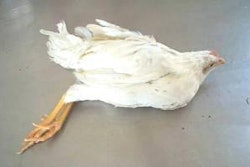Maro Ibarburu, program manager for the Egg Industry Center (EIC) located at Iowa State University, released the August-September Statistical Report on October 14.
The recent egg recall in Iowa affecting approximately 6 million hens, of which half may have been depleted, continues to distort projections of price and hen numbers.
The USDA-NASS now reports a national average price to producers where previously values were provided for each state. To calculate the producer price for the six U.S. regions the EIC is now using a basis of 47 cents per dozen for California and the Northwest and 35 cents per dozen for the remaining four U.S. regions. These values are derived from the Urner-Barry (UB) quotes less a provision for packing, which will vary over time.
The current report as distributed by the EIC is summarized for readers of Egg Industry but data generated by using models are appropriate in times of relative stability lose validity during short-term turmoil.
- The U.S. estimated cost of production for September 2010 was 62.3 cents per dozen ex-farm, 4.1 cents per dozen or 7% less than the previous month. The range in production costs among regions extended from 57.3 cents per dozen in the Midwest to 66.5 cents per dozen in California.
- The margin represented by “income minus cost” for September dropped to -17.7 cents per dozen from the positive margin of 4.2 cents per dozen reverting to the negative trend during May through July. This trend is attributed to a combination of a 28.5% decrease in revenue and a 10.6% escalation in feed cost. For the first nine months of 2010 the average margin was 6.1 cents per dozen.
- In evaluating the reduced margin for September it was noted that feed cost was 38.42 cents per dozen, with pullet depreciation at 9.2 cents per dozen and other fixed and variable costs of 14.7 cents per dozen, applying the standard cost factors used by the EIC. These values remained unchanged through the first eight months of 2010.
- Contribution per hen, based on September figures was -32.7 cents per bird which was a substantial deterioration from the positive 8.1 cents in August. The cumulative nine-month hen contribution now stands at 103.4 cents per bird.
- The Urner-Barry (UB) simple average producer price for six U.S. regions, assuming 76% large eggs, was 49.7 cents per dozen for September compared to 70.0 cents per dozen in August 2010. The nine-month cumulative simple average UB price was 64.9 cents per dozen.
- The USDA-AMS determined an ex-farm price of 58.9 cents per dozen for September compared to 77.14 cents per dozen in August. Corresponding warehouse/DC and DSD prices were 83.17 and 88.67 cents per dozen respectively. The farm to store spread was 29.71 cents per dozen.
- In reviewing retail prices for table eggs, the Bureau of Labor Statistics and the Department of Commerce estimated an August average of 151.9 cents per dozen, 6.9% lower than the August 2010 value of 163.2 cents per dozen. The simple average retail egg price for the first eight months of 2010 was 165.5 cents per dozen.
- The large- to medium-grade white egg price spread over six regions was 22.8 cents in September compared to 27.5 cents per dozen in August with an average spread of 19.7 cents per dozen during the first nine months of 2010. Regional spreads ranged from 21.7 cents per dozen in the Northeast to 33.8 cents per dozen in the North West region, a significant widening compared to values for August.
- During September 2010, layer feed averaged $229.40 per ton, which is 11.5% higher than the nine-month average of $205.60 per ton based on six regions. During September the price range among regions was $203.40 per ton in the Midwest rising to $250.60 per ton in California. The differential of $47.20 per ton is equivalent to approximately 8.3 cents per dozen applying realistic industry production parameters.
- For the first nine months of 2010, commercial-egg strain eggs in incubators have remained almost constant at an average of 38.80 million with a range of 33.4 million in August to 42.9 million in April. The corresponding 2009 value for the first nine months of 2010 was 36.54 million.
- Straight run hatch for August attained 37.0 million with an average for the first eight months of 41.54 million.
- Projections for pullets to be housed in future months based on the five months-previous hatch and incorporating a 5% mortality factor, include a range in the increase in placements from 15.75 million pullets in April to 21.44 million pullets in September 2010. The 12-month average of 18.21 million pullets per month for 2010 is 5.5% greater (1.0 million pullets) than the 12-month average of 17.26 million per month for 2009. The 2006 to 2010 monthly average was 16.60 million pullets placed each month.
- For August 2010, the USDA-NASS estimated the national flock at 281.8 million hens, which is 1.4 million more than in July 2010, following seasonal trends. Applying the University of California model based on USDA-NASS data for chickens and eggs, it is estimated that the December 2010 flock will attain 290.6 million hens This incorporates the assumption of 9% mortality from 20 through 72 weeks of age.
- As at the end of August 2010, 23.2% of the national flock was over 72 weeks of age. With the exception of March 2010, which was an aberration, the seasonal pattern of a decline in molted flocks from January through April appears to be holding although this may be affected by depletion of SE-positive flocks in the Midwest. For the entire year of 2009, an average of 24.7% of the national flock had been molted compared to 31.7% in 2008.
- During August 2010 5.64 million hens were depleted, corresponding to the eight month average of 5.85 million hens. The value for September should quantify the extent of slaughter of SE-positive flocks in Iowa.
- Six regions reported a simple average of 23.7% molted hens in September 2010 reflecting all states surveyed by the USDA-NASS. The actual proportion of molted hens in the U.S. varies widely, from 7.8% in the Northeast to 33.8% in the North West. The nine-month average of 23.7% molted hens in the U.S. flock and differences among regions reflect production costs, revenue for eggs and realization value for spent hens.
- According to the projections developed by the University of California, the most recent estimate of the national table-egg flock for September 2010 is 283.0 million hens. This number is expected to increase steadily to 291.2 million in December 2010. Given current projections of prices which are functions of supply and demand, flock sizes could be trimmed by depletion especially following evidence of SE infection and if consumer demand does not increase. Compensatory increased retention of known SE-negative flocks may occur in regions or for specialty product subject to available capacity including re-caging. Prolonged depression in price beyond current estimates will inevitably result in a decrease in hen numbers since flocks will be depleted at a rate faster than projected.
- In July the University of California projected an UB large Midwest price of 117.3 cents/dozen for September which was depressed to 89.7 cents per dozen by the SE recall. The previous projections in the 140s for November and December have been revised to 108 cents per dozen. This value will only be achieved if there is a marked restoration in consumer demand. Although the UB price bottomed at the end of the third week in September demand and hence prices are not recovering with a velocity which would contribute to the October University of California forecast. It is reiterated that a 30 cent per dozen difference in UB price between forecast and actual as a result of the SE recall associated with one producer group in Iowa will cost the industry $90 million to $95 million per month over 165 million hens producing generic eggs. The prospect for a rise depends on there being no further recalls with positive media reports projecting that the problem of SE is contained and is not a general reflection on the industry and the safety of our product.
- In August, the top six egg-producing states with 160.7 million hens represent 57.9% of the total national flock of 277.34 million hens. In descending order these states are Iowa (19.7% of total), Ohio (8.2%), Indiana (8.3%), Pennsylvania (8.3%), California (6.9%), and Texas (4.9%). States reporting to the USDA-NASS represent 98.4% of all hens producing table eggs. It remains to be seen whether a disproportionate cull of SE-positive hens occurred in Iowa in September.
- Rate of lay for the first eight months of 2010 attained 76.0%. This is higher than in 2009 during which an average of 75.4% was recorded. The positive difference of 0.6% in production level is equivalent to a daily volume approaching 4,800 cases. Average rate of lay is a function of weighted flock age and is also influenced by climatic conditions. It is noted that July-September temperatures in the regions with the highest density of production were unseasonably high in 2010.
- During August 2010, 5,884 million cases of eggs were broken under federal inspection, which is 1.9% less than in July and 2.7% more than in July 2009. For the first eight months of 2010, egg breaking was up by 2.0% over the corresponding period in 2009. For the year to date, 31.4% of the 144,167 million cases produced were broken compared to 30.8% for the entire year of 2009. It is noted that the proportion of eggs broken has steadily declined from the 2005 high of 35.1% to a projected value of 30% for 2010. Values for the proportions of eggs broken in September and October respectively (as yet unavailable), will be influenced by diversion due to SE in Iowa. Values should remain at a high level until affected flocks are depleted prematurely as unit breaking revenue has declined precipitously for this class of eggs, rumored to be in the region of 20 cents per dozen.
- The revised egg consumption value for 2010 is projected to be 246.9 per capita, almost 1.0%, lower than the 247.7 eggs per capita recorded in 2009. Over the past seven years the highest per capita consumption of 257.8 eggs was recorded in 2006. Values for the last quarter of 2010, estimated at 63.2 eggs per capita by USDA-ERS will have to be revised downward in response to the adverse publicity associated with the SE recall.
- During July 2010 the USDA-FAS recorded exports of 195 thousand cases of shell eggs contributing to a seven-month total of 2,610 thousand cases representing 0.99% of production. Major importers during 2010 to date were Hong Kong/PRC at 43.1% and Canada (22.1%)
- Exports of egg products expressed as shell-egg equivalents attained 2,610 thousand cases for the first seven months of 2010 representing 2.1% of U.S. production. The cumulative export of products has been 28% higher in 2010 to date compared to the corresponding period in 2009. Major importers in 2010 have been Japan (25.2%), Germany (20.3%), Canada (11.1%) and Mexico (5.0%).

















